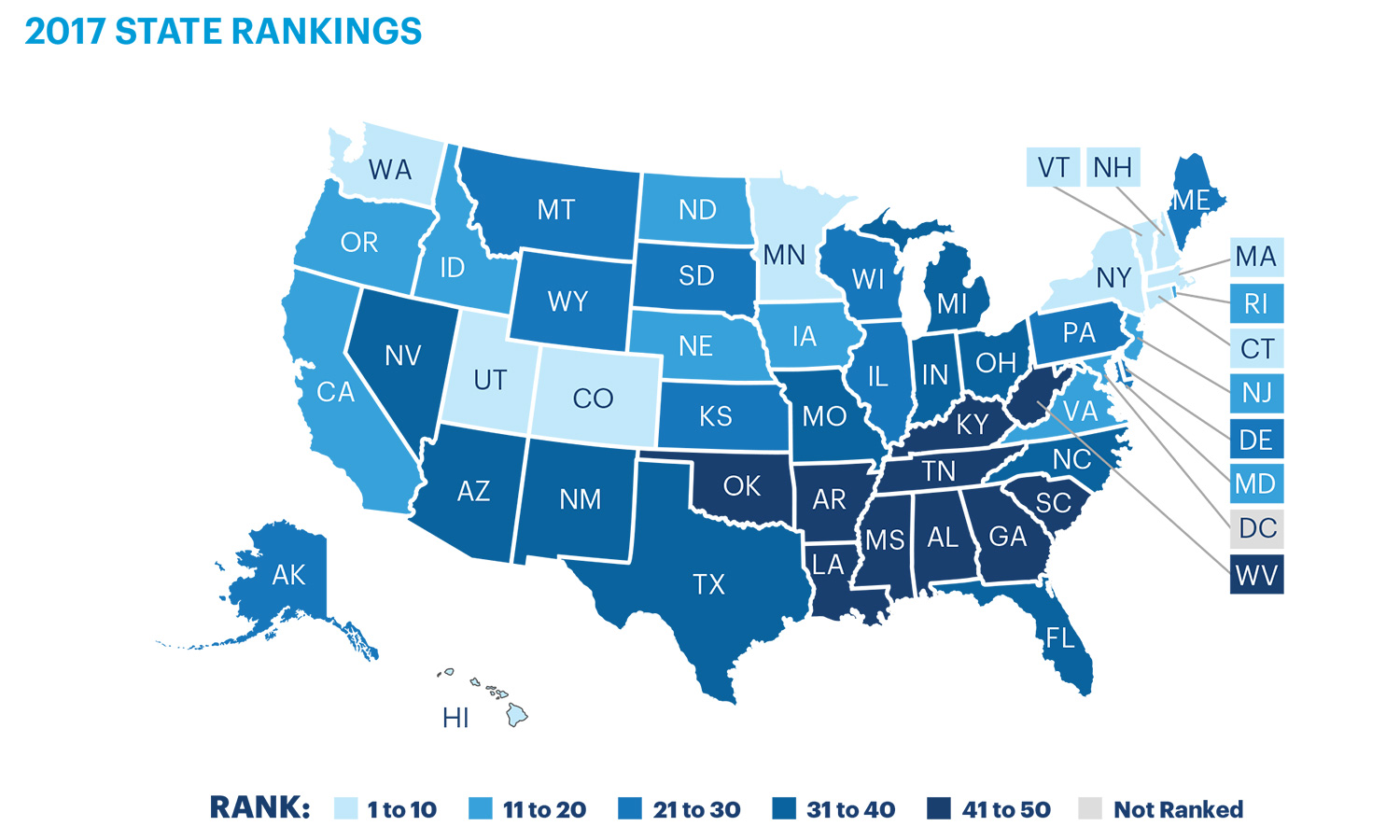Massachusetts Unseats Hawaii As Healthiest State

Chilly Massachusetts has bumped sunny Hawaii from the top spot as the healthiest state in the nation, a new report finds.
The Bay State is the healthiest state in the union, according to the new report from the United Health Foundation. Hawaii, which held the No. 1 spot for five years, is now the runner-up, followed by Vermont, Utah and Connecticut. (The United Health Foundation is affiliated with United Healthcare, a health insurance company.)
The five lowest-ranking states are Mississippi (50), Louisiana (49), Arkansas (48), Alabama (47) and West Virginia (46). Mississippi and Louisiana, in particular, struggle with high rates of smoking, obesity and children living under the poverty line, according to the report. [Which States Rank Best and Worst]
Ranking America's health
The annual report ranks states based on 35 different public-health measures, including death rates, percent of the population with insurance coverage, concentration of health care providers and rates of preventable hospitalizations. It also takes into account behavioral measures such as smoking and physical activity, and considers the impact of race, education, income and other demographic factors on health disparities.
Massachusetts has been climbing in the rankings since the first report was released in 1990, according to the United Health Foundation. It reached the top slot in part because it has the lowest percentage of uninsured at 2.7 percent; a high concentration of mental health providers, at 547.3 per 100,000 people in the population; and low obesity rates.
Overall, Massachusetts scored best of any state in health care policy and clinical care quality. It also ranked third in the subcategories of prevalence of health-promoting behaviors and a healthy community and environment. The state also had a relatively low rate of cardiovascular deaths (208.3 per 100,000 people) and cancer deaths (183.6 per 100,000 people). [9 Healthy Habits You Can Do in 1 Minute (Or Less)]
Massachusetts did rank in the bottom 10 for drug deaths, however, with 19.8 drug deaths per 100,000 people. It was in the middle of the pack for infant mortality (4.4 deaths per 1,000 live births) and for premature death, defined as years lost before age 75 (5,970 years per 100,000 people).
Sign up for the Live Science daily newsletter now
Get the world’s most fascinating discoveries delivered straight to your inbox.
For comparison, the last-ranking state, Mississippi, actually had few drug deaths than Massachusetts, with 11.5 drug deaths per 100,000 people. The state fared poorly in premature deaths (10,950 years lost per 100,000 people) and in cancer deaths (226.7 deaths per 100,000 people). Cardiovascular death rates in Mississippi were 352.5 per 100,000 people, and the infant mortality rate was 8.8 deaths per 1,000 live births, making it the worst state for infant mortality.
Health in context
The rankings highlighted the vast differences in health and health care across the country.
For example, Massachusetts has more than six times the concentration of mental health providers than Alabama, which has the lowest concentration of any state at 85 providers per 100,000 people.
The highest-ranking states in availability of primary care doctors (Massachusetts, Connecticut, Rhode Island and New York) have more than 200 per 100,000 people, twice that of the lowest-ranking states (Utah and Idaho), which have fewer than 100 per 100,000 people.
Unfortunately, all of the rankings are superimposed upon alarming national trends, the report said.
Across the nation, the premature death rate is up for the third consecutive year, with 7,214 years lost before age 75 per 100,000 people, according to the report. This is a reversal from 1990 to 2015, which saw premature death rates decline.
Drug deaths are up 7 percent nationally since last year, and cardiovascular death rates are up 2 percent since 2015. Even the healthiest state, Massachusetts, has seen its rate of drug deaths rise 69 percent since 2012. Rhode Island, Ohio, New Hampshire and West Virginia have also seen large increases in drug deaths since 2012, according to the report. Florida is the only state to witness a decline in drug deaths in that period.
Rates of obesity, new cases of certain sexually transmitted diseases and violent crime have also ticked up in past years.
There is some good news, however. Smoking declined in all 50 states since 2012. The number of current smokers declined 2 percent since last year, from 17.5 percent to 17.1 percent of American adults.
In addition, air pollution continued to decline, as it has since the America's Health Rankings report started tracking it in 2003.
And the proportion of children living in poverty declined for the second year running, from 19.7 percent in 2016 to 18.0 percent in 2017. The Affordable Care Act, popularly known as Obamacare, had a noticeable effect on insurance rates, with the percentage of uninsured people declining from 16 percent in 2012 to 9 percent in 2017.
Originally published on Live Science.

Stephanie Pappas is a contributing writer for Live Science, covering topics ranging from geoscience to archaeology to the human brain and behavior. She was previously a senior writer for Live Science but is now a freelancer based in Denver, Colorado, and regularly contributes to Scientific American and The Monitor, the monthly magazine of the American Psychological Association. Stephanie received a bachelor's degree in psychology from the University of South Carolina and a graduate certificate in science communication from the University of California, Santa Cruz.










